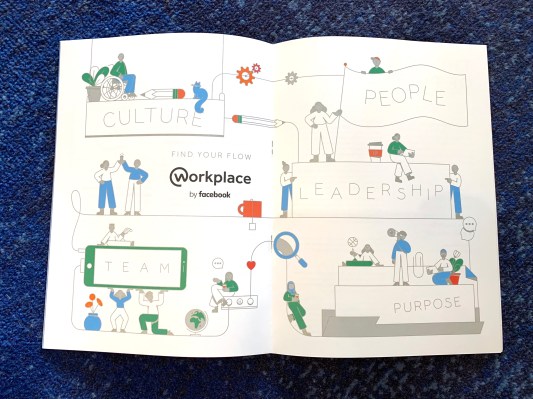Workplace, the version of Facebook tailored to enterprises that has over 30,000 organizations as paying customers, is ramping up the service today with a rush of new features to help it competes with the likes of Slack and Microsoft’s Teams.
The additions are being announced at a new, standalone conference called Flow — the first time Facebook has built what’s likely to become a recurring event for a specific product, Workplace’s head Julien Codorniou told me in an interview. He described Workplace as “Facebook’s first SaaS startup.” He tells us that for existing clients, the goal of Flow is to show off new features that deepen employee engagement with Workplace so they can’t imagine switching away. And for enterprise software partners Facebook integrates with, it’s to foster an ecosystem surrounding Workplace so it can adapt to any business.
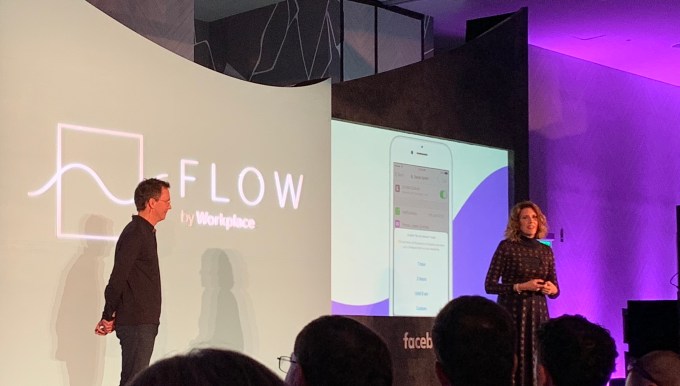
In a big upgrade to the “chat” features of Workplace (conversations that happen outside the news feed, first launched last year), users will now be able to start chats, calls and video conversations either one-to-one or in groups, in the style of WhatsApp or Messenger. Facebook is also making it easier to navigate through high volumes of messages in your channels by adding in replies, do not disturb and pinning features — Facebook’s first move to bring in algorithmic sorting to Workplace. And Facebook is also bringing its Safety Check feature from the main app to Workplace, delivered via Workchat, as a tool that can be controlled by admins to check on the status of employees during a critical incident.
Workplace has picked up 30,000 businesses as customers in the two years since it launched (including some biggies like Walmart, the world’s largest employer); and today it also added a couple of notable large enterprises to the mix: GSK, Astra Zeneca, Chevron, Kantar, Telefonica, Securitas, Clarins UK, Jumia and GRAB.
But Facebook has never revealed how many users (or “seats”, in enterprise parlance) it has on Workplace. As a point of comparison, Slack today has 8 million users across 70,000 organizations, and Facebook hasn’t updated its 30,000 figure in a year.
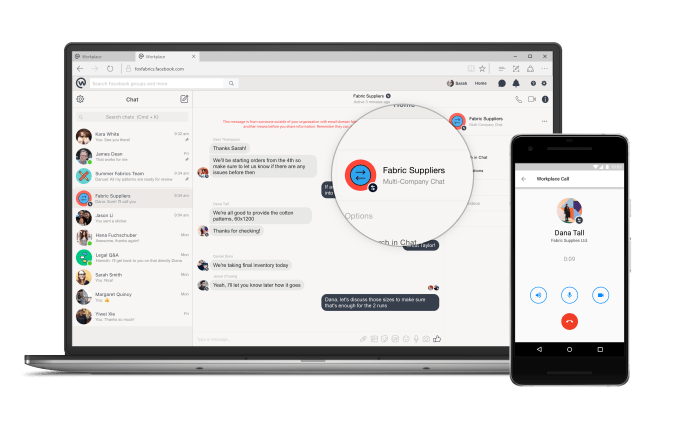
Facebook Workplace multi-company chat
The range of features Facebook is introducing today are notable both for their breadth and for what they are aiming to do. Some help put Workplace more on par with the core Facebook experience in terms of functionality, but ultimately they are all squarely aimed at making Workplace into something that fits more closely with how enterprises already use IT.
The chat features that are being incorporated build on the minimal chat features that were already present in Workplace and essentially create something like WhatsApp or Messenger that sits within the same secure framework as Workplace itself. It’s effectively Facebook’s first step forward into unified communications — a specific branch of enterprise IT that used to be centred around PBXs and other expensive physical equipment, but has more recently become more virtualised with the rise of voice of IP and cloud-based systems that can be used over any internet connection.
Workplace had already had a feature in place for up to 50 companies to converse in multi-organizational conversations on the platform, and now if some members of those groups want to take the conversation to a more direct channel potentially with voice or video calling, they can do that directly from within the app without having to open a separate messaging client (which may or may not be under the control of IT). Up to 50 people can join a video call in Workplace.
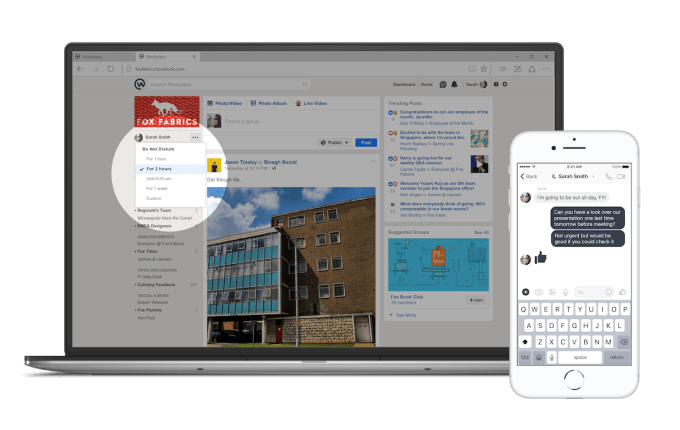
The three features that help you better organise your conversations — do not disturb, replies and pinning important items — will be especially welcome to people who have especially “noisy” channels on Workplace.
Replies, Codorniou said, will work “like on WhatsApp” — where you can select a message and reply to it and it will appear with its mini thread later in the feed.
But they are perhaps most notable of all because they will be the first time that Facebook is introducing “algorithmic” sorting to Workplace. For those who already use normal Facebook, or Twitter, or other social media services, algorithmic sorting is something that is well-known, as it plays with the sequence of posts to show you what is deemed to be more important, versus what’s most recent.
In the case of pinning, Facebook is letting the IT admins, and users, effectively play a part in the algorithmic sorting: Admins can pin “important” posts to the top of a feed, and that will affect what users see and can respond to first. “If the CEO posts a message, this might be more important than something posted an intern,” he said.
Do not disturb, meanwhile, will let users set times when they do not get pinged with messages, but when you “return” again to Workplace, Facebook decides what gets sorted to the top of what you view.
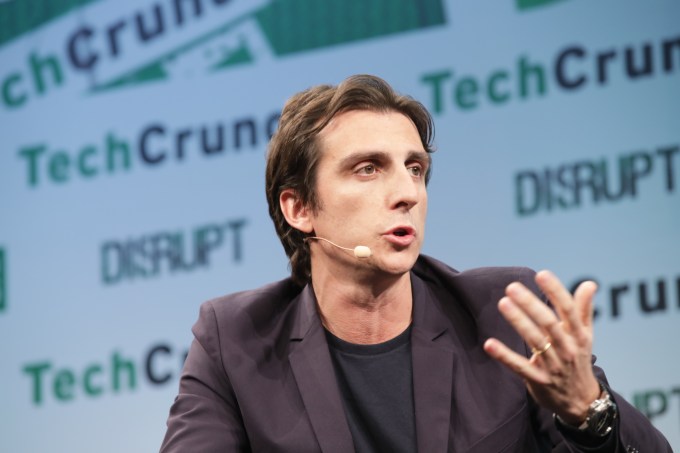
Facebook’s VP of Workplace Julien Codorniou
Codorniou notes that Facebook uses machine learning and AI “to make sure that if you don’t use Workplace for two weeks [as an example] you have the most relevant information on top of the news feed.” Signals that it uses to sort include who you work with, and which groups you are most active in. “It’s algorithmic by default,” he noted, and added that this was something that was requested by Workplace users. “People don’t believe in the chronological feed anymore,” he said. “It’s important to guarantee reach to communications teams.”
The Safety Check also fits into this concept. Here, Facebook will be putting IT managers/Workplace admins into the driver’s seat, “giving them the keys to the feature”, said Codorniou, and letting them control the use and distribution of a feature that in regular Facebook is controlled by Facebook itself.
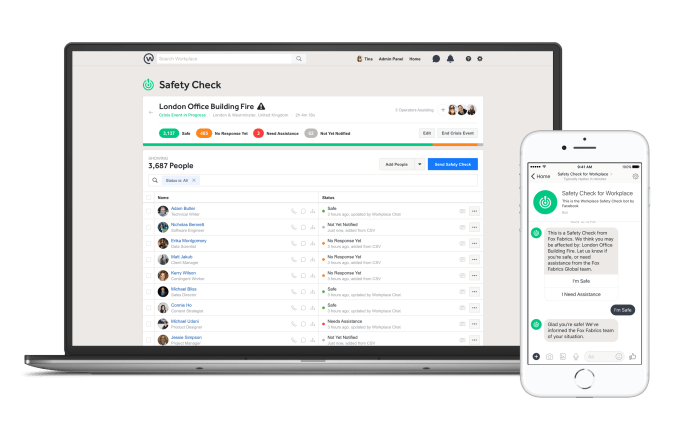
Frederic takes a deeper diver into Safety Check here, but the main idea, as Codorniou described it to me, is that it allows companies “to track and clear who is safe and who is not” when a particular location has been through an emergency or critical incident. There are apps that companies can use to run safety checks, or sometimes they might use SMS, but these tend to work more manually and are harder to execute quickly, he said. Facebook doesn’t reveal how well penetrated their apps are at organizations like Walmart and Starbucks, but this potentially becomes one lever to helping get Workplace distributed more widely.
“Employees are a company’s number-one asset of the company, and this helps make sure you are safe,” he added. “People don’t want to play Candy Crush, but things like Live” — which Workplace launched last year — “and Safety Check are relevant. They help turn companies into communities.”
(Community, of course, is the big theme for Facebook these days.)

All these updates are happening at a time when many people have been scrutinising Facebook for its approach to user privacy and personal data.
The issue was notably highlighted over the Cambridge Analytica scandal many months ago, specifically over how third parties were able to access users’ information; and then more recently Facebook faced criticism two weeks ago, when it emerged that a bug in one of its features exposed user information to malicious hackers. Both of these problems were squarely about Facebook’s core consumer app, but I couldn’t help but wonder what kind of an impact it has had on the company’s enterprise business — given that levels of security in workplace networks typically tend to be higher as they are connected to corporate information.
“We had a few questions of course but we have no reason to believe that Workplace was affected,” Codorniou said. He noted that there had once been a feature to log in to Workplace using a user’s Facebook ID, but that was disabled some time go. “We have been investigating, but most customers are on single sign on,” he noted, which uses services like Okta, One Login and Ping to connect and sign in employees to their Workplace spaces.
Facebook’s scale brings it huge advantages in the enterprise. The consumerization of the office stack means Facebook can easily port over its familiar features. It’s big enough to extensively dogfood Workplace within the company. And it already has advertising relationships with many of the world’s top brands. But being a tech giant comes with the associated scandals and constant criticism. Facebook will have to convince business leaders that its social troubles won’t muddy their suits.
